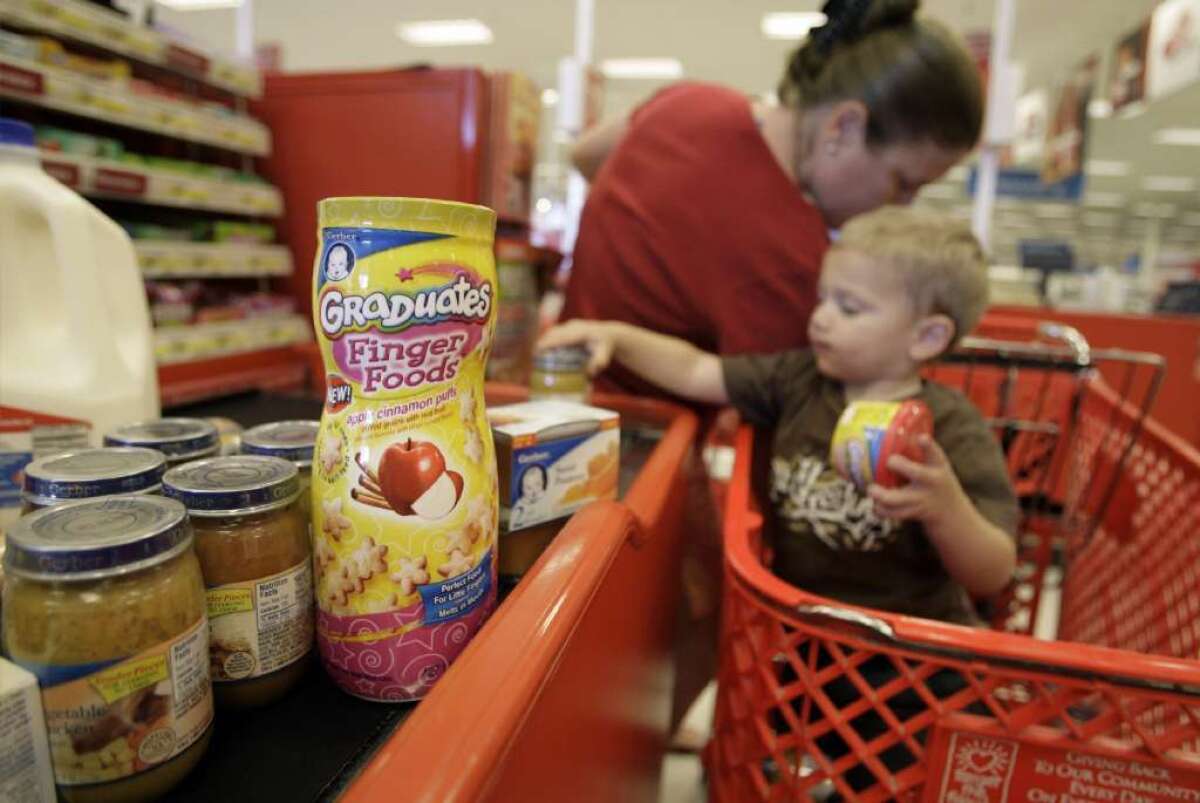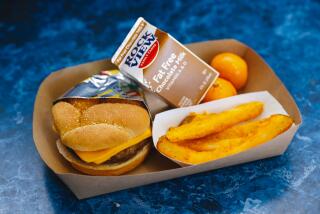Too much sugar and sodium are on the menu for toddlers, study finds

- Share via
Americans’ atrocious eating habits start incredibly young, according to a new, comprehensive analysis of foods sold for infants and toddlers.
About one-third of dinners made for toddlers contained at least one kind of added sugar, researchers from the Centers for Disease Control and Prevention found. So did 97% of breakfast pastries and cereal bars for this age group. Even 88% of juices and other drinks marketed for infants and toddlers are spiked with added sugar.
In addition, 72% of toddler dinners were judged to be high in sodium, with an average of of 2,295 milligrams of sodium per meal. The Institute of Medicine recommends that toddlers consume no more than 1,500 mg of sodium a day.
Among 34 types of savory snacks for infants and toddlers – a category that includes crackers, some types of rice cakes and mini-hot dogs sold in jars – the average concentration of sodium was 486 mg per 100 grams of food. In comparison, salted potato chips intended for adults have about 450 mg of sodium per 100 grams, the researchers noted in their study, which was published Monday by the journal Pediatrics.
With foods such as these on the menu, it’s not surprising that 23% of American kids between the ages of 2 and 5 are considered either overweight or obese. Children who are obese or who eat too much sodium face an increased risk of high blood pressure, which can carry over into adulthood and make them vulnerable to cardiovascular disease, among other health problems.
So the researchers, from the CDC’s Division for Heart Disease and Stroke Prevention and its Division of Nutrition, Physical Activity, and Obesity, set out to get a better handle on the amount of sodium and sugar in prepared foods designed for the nation’s youngest eaters.
They scoured a commercial database that includes nutrition information on more than 200,000 prepared foods. They also walked the aisles of Wal-Marts, Targets, Costcos and supermarkets in the Atlanta area to find additional products for their analysis. Altogether, they included 1,074 food items for infants and toddlers in their sample.
Some of their findings were reassuring. For instance, among 657 infant vegetables, fruits, dry cereals, dinners and ready-to-serve items that combined mixed grains with fruit, all but two were considered low in sodium. In addition, more than 80% of the 582 fruit, vegetable, soup and dinner items for infants had no added sugars.
But after kids turned 1 and graduated to toddler foods, the options worsened. Cereal bars, fruit and dry fruit snacks for this age group were still low in sodium, but most contained at least one type of added sugar. The most common of these was “fruit juice concentrate” – an ingredient that some parents might assume is “a healthful part of the food,” according to a pair of pediatric gastroenterologists who wrote a commentary that accompanies the study.
“Early life exposures to sodium and sugar can set taste preferences and determine health trajectories,” wrote Dr. Susan Baker and Dr. Robert Baker of the University of Buffalo.
The study authors noted this too and expressed concern that the offerings for the youngest eaters would set them up for a lifetime of poor eating habits. Pediatricians should advise parents to limit the amount of juice they give their children and steer clear of sugar-sweetened beverages and high-calorie snacks with little to no nutritional value, they wrote. (The Bakers went so far as to suggest that parents cook from scratch instead of feeding their kids processed foods.)
The data on sodium and sugar came from the Nutrition Facts labels that appear on food packages. These aren’t necessarily accurate because the U.S. Food and Drug Administration allows the figures on the label to be off by as much as 20%, the researchers noted.
For more disheartening news about American diets, follow me on Twitter @LATkarenkaplan and “like” Los Angeles Times Science & Health on Facebook.






